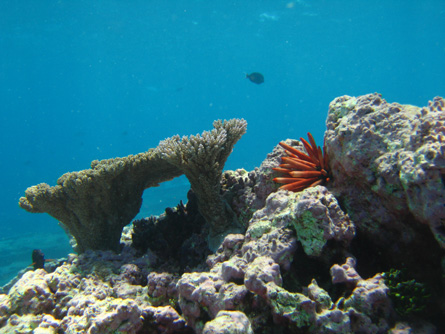|
You
are here: /main/research
expeditions/May 2006/Day
21 Johnston Atoll
Day
21, The journey back from Johnston Atoll
Morning
of June 9, 2006
by
Dr. Malia Rivera

The bluefin chromis is common at Johnston Atoll but rare in Hawai'i. The fire coral
dominates the outer reefs of Johnston, but is not found in the Hawaiian archipelago.
After a productive week at the lonely Johnston Atoll, the Hi‘ialakai started the long trek back
to O‘ahu on Wednesday night. Eight hundred nautical miles away, the journey will take us more
than three and a half days. Johnston was indeed an interesting place, so many similarities
to the Hawaiian archipelago, but at the same time, so unique. While many of the reef species
are the same as those found in Hawai‘i, their relative abundances appear to be quite different
in many respects, making the appearance of the overall reef rather distinct to the observer.
Johnston is said to contain a “subset” of Hawaiian fauna, that is, most of the coral reef
organisms at Johnston are also either endemic or native to Hawai‘i. Biologists believe that
a current exists that transports the small juvenile forms, or larvae, between the two places
in a two-way exchange, such that Johnston acts as a stepping-stone for colonization of species
between Hawai‘i and the South Pacific.

A young table coral and slate pencil urchin at Donovan's Reef inside the lagoon at Johnston Atoll.
The HIMB team plans to explore this connection more thoroughly in a number of ways.
The invertebrate population genetics team and the reef fish population genetics team
will use DNA analyses to characterize the genetic affinities of the two regions. The
apex predator-tagging group has deployed an acoustic receiver at a place called
“Shark’s Ledge,” to pick up any signals from sharks that have been tagged in the
Northwestern Hawaiian Islands and have migrated down to Johnston Atoll. The coral
disease team has found an alarmingly high percentage of Acropora white syndrome at
Johnston, and plan to continue monitoring its spread up in to French Frigate Shoals.
Coral bacterial community and symbiotic zooxanthellae genetic studies will shed
light on the susceptibility of corals to some of these diseases that threaten the
reefs in both the NWHI and Johnston.
During this transit time the researchers do not rest, but continue to toil away on their computers.
No longer in diving mode, they are now fully engaged in compiling data on their sampling, and
starting the arduous task of preparing detailed cruise reports. Most of this work will then
continue using cutting-edge tools in laboratories at HIMB, in many cases taking months to
process all the samples. They will use the high-tech molecular core facility back at
Moku o Lo‘e (Coconut Island) to generate large scale DNA sequence and fingerprinting
data as part of the array of genetics research programs. Along with the new information
from coral disease monitoring, HIMB will be able to provide the NWHI Coral Reef Ecosystem
Reserve office with new information that will be of great value in designing a science-based
management strategy for the precious Northwestern Hawaiian Islands.
|